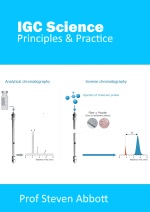IGC Science: Principles and Practice
A free eBook linked to the apps in Practical Chromatography

IGC, usually known as Inverse Gas Chromatography but which I prefer to call Interfacial Gas Chromatography is a powerful technique for exploring the interfacial behaviour of (especially) particle surfaces. This booklet has two purposes. The first is to provide a guide to what IGC can currently do for you. The second is to point out the fundamental flaws in how IGC has been used in the past, and how it can be developed into something far more insightful for those wishing to better understand what is going on at the surface of their (complicated) particles.
Contents
- Asking the Right Questions
- The right way to do IGC either at Infinite Dilution, or Finite Concentration, on the right equipment
- Why surface energy is usually unimportant
- Surfaces and Individual Probes: IGC-ID
- "Surface energy"
- Surface structure
- Specific polar and H-bonding interactions
- Why most "surface energy" values are wrong
- Surfaces Fully Covered: IGC-FC
- AEDF, BET etc.
- Bulk measurements
- Diffusion coefficients
- HSP
- Surface or Bulk
- RIM and beyond
- How not to do IGC
- Links to Other Techniques
- BET Surface Area
- Washburn Surface Energy
- SEM, X-rays etc.
- The future of IGC
- Beyond "more of the same"
- Ideas for the future
 The book is Copyright © 2018 Prof Steven Abbott and is distributed under the Creative Commons BY-ND, Attribution and No-Derivatives license.
The book is Copyright © 2018 Prof Steven Abbott and is distributed under the Creative Commons BY-ND, Attribution and No-Derivatives license.
Downloading
You just click to download it and start reading in the format of your choice. By linking to the apps in Practical Chromatography you get all the benefits of the live apps. On an iPad, for example, a click on a link takes you to see it in Safari and a 4-finger swipe allows you to go back and forth between book and app. On a laptop it's even easier to swap between the two views.
You can download it in any format(s) you find useful. The table of contents in each of the formats (including PDF) is "live" so it is very easy to find what you want. Most eBook readers have a search function so the book doesn't need or have an index. You can choose your reading experience. Some like to read page-by-page but it can be difficult if a diagram or a formula is on a different page in your specific view. Others like a scrolling view which is less book-like but is easier to move back and forth to check diagrams and formulae.
With formats other than PDF there is an issue about footnotes. The best eReaders allow pop-up footnotes which just appear when you click them, but such support is erratic so I have placed all footnotes at the end of the paragraph - the least bad option.
- PDF. IGC Science Principles and Practice.pdf. [If you want to download it, use right click.] On a high-res tablet or laptop, PDFs offer a good reading experience and it is the simplest to get going; on a smartphone it may be less pleasant to read.
- ePub3. IGC Science Principles and Practice.epub. This works on phones, tablets, PCs, Macs with modern ePub3 readers such as iBooks, Calibre, Azardi, IceCream etc. How do you get it into, say, iBooks? I use Dropbox on my iPad and choose iBooks to run it. You may find other ways via, say, email.
- Kindle mobi. IGC Science Principles and Practice.mobi. Mobi is generally agreed to be a deeply unsatisfactory format and it is frustratingly hard to get the format right, but Amazon continues to use it so we all have to produce it as best we can. This version seems to work OK but don't blame me if there are glitches. How do you get it into your Kindle reader? On my PC I simply put the file into the My Kindle Content folder and run Kindle for PC (it won't work on the Windows App version) where it automatically appears in my available books. I don't have a stand-alone Kindle reader so I don't know how to get it on to one of those, but I believe it is not too hard. For simplicity/reliability, footnotes are at the end of the relevant paragraph.
Updatable
Version Information
- 1.0.0 7 October 2018.
- Initial release
- 1.0.1 19 April 2020.
- Text tweeks thanks to Lee McManus
One of the joys of producing my own book and giving it away is that I can rapidly respond to the reader community. I can quickly fix typos, reword passages that are unclear, improve the layout within a given reader. More importantly, if there is science that is incomplete, wrong or missing I am happy to do my best to fix the problem. I can't do this without your help, so please email me at steven@stevenabbott.co.uk if you want me to make improvements.
Where does the science come from?
My task has been to find the good, useful scientific principles and distill them into words and apps that allow people like me to use the principles in practice. In addition to reading books and many academic and conference papers, I've had the chance to interact personally or via email with some of the world's IGC science experts. All through the book, and in any app where I needed help with the algorithm, I acknowledge their generous inputs. All the credit for the science goes to them. All the blame for errors in describing and implementing their science goes to me.
Happy reading!
Steven

